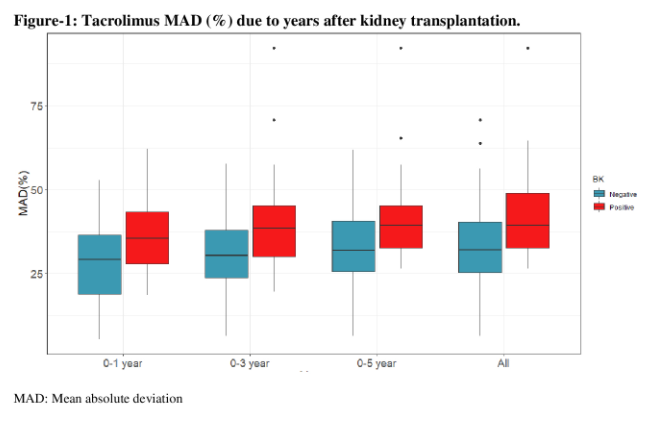Intra-patient tacrolimus level variability in BK virus associated nephropathy
Didem Turgut1, Deniz Ilhan Topcu2, Siyar Erdogmus1, F. Nurhan Ozdemir1, Mahir Kirnap3, Mehmet A. Haberal3.
1Nephrology, Baskent University, Ankara, Turkey; 2Medical Biochemistry, Baskent University, Ankara, Turkey; 3Transplantation, Baskent University, Ankara, Turkey
Introduction: Tacrolimus is a potent immunosuppressive drug but has a narrow therapeutic window with considerable intra-patient variability (IPV) in its pharmacokinetics. Tacrolimus IPV is related to fluctuation of blood concentrations over a period of time and was claimed to be a predictor of inferior outcomes in kidney transplantation. But tacrolimus IPV and BK virus nephropathy (BKVN) correlation is not known. The aim in this study was to analyze whether high tacrolimus IPV (>30%) rates were also a risk factor for BKVN in kidney transplant setting.
Materials and Methods: We analyzed patients on tacrolimus+mycophenolate+steroid for kidney transplantation between 2009 and 2019 retrospectively. In this case-control study 22 biopsy proven BKVN patients were compared with 60 normal graft function patients. BKVN group had graft loss during 5 year, while control group had >5year-graft survival. BKVN group patients had graft biopsy because of serum creatinine increase. Patients <18 years-old and graft loss before 5 year were excluded. IPV was calculated as mean absolute deviation (MAD %) with the formula; MAD%= 1/n x100c. 0-1 year IPV, 0-3 year IPV and 0-5 year IPV levels were analyzed.
Results: Twenty-two BKVN patients and 60 normal graft function patients were analyzed retrospectively. Mean serum creatinine level was higher in BKVN group as expected (2.24±0.52 vs 0.95±0.17, p=0.002). 0-1 year IPV (37.10±12.2 vs 28.35±11.9, p=0.012), 0-3 year IPV (41.31±16.1 vs 31.43±10.7, p=0.006) and 0-5 year IPV (42.50±14.92 vs 33.02±10.8, p=0.005) were higher in BKVN group (Figure-1). All BKVN patients were with high IPV (>30%) during 3rd and 5th year of transplantation.
Conclusion: BKVN is a serious complication of kidney transplantation and high tacrolimus IPV is prominent in this condition. High IPV mainly may be related to drug/dose changes to stop over-immunosuppression. While reducing immunosuppression during BKVN, it must be in kept in mind that instable tacrolimus levels are may be related under-suppression and graft loss after BKVN.

There are no comments yet...